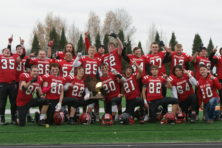Year in Review 2018: Fits and Starts in Sturgeon Bay
- Share
- Tweet
- Pin
- Share
A familiar pattern continued in Sturgeon Bay in 2018, with each step forward followed by a step backward.
When the year began, the idea of preserving the much-discussed Teweles and Brandeis grain elevator appeared doomed. The common council awarded a demolition contract to Kiesow Enterprises, and it seemed the controversy – for better or worse – would soon end.
But at the 11th hour, a donor stepped up to purchase the granary and move it to a new location on the east side of the bay. On March 29, the structure was raised onto wheels and driven at a snail’s pace across the Oregon Street Bridge to its new, temporary home on the east side. It wouldn’t be the end of the story.
As the granary fight heated up, the DNR finally issued a ruling in February that seemed to put a different controversy to bed. The department issued a declaratory ruling on the ordinary high water mark on the west-waterfront between the Oregon Street Bridge and the Maritime Museum that put much of the property below the high-water mark, meaning it cannot be used for private development.
Just days after the granary was moved, voters sent a resounding message to city hall, electing three newcomers to the council. Among them was Kelly Avenson, whose election turned the council’s makeup to majority women for the first time in history.
The new council immediately set about changing the direction of the city, moving to dissolve the Waterfront Redevelopment Authority that, for 37 years, had controlled development of the city’s waterfront. In its place, the council created an ad hoc committee to start anew on plans for the west waterfront.
The council’s next move did not go as smoothly, however. Alderwomen Kelly Catarozoli and Kelly Avenson requested that the city review the employment of Administrator Josh VanLieshout – a request that fell embarrassingly flat when it was revealed the city does not have a process in place for annual reviews of the administrator or city department heads.
Also in July, the city finally resolved the issue of the dirt piles that had dominated the west waterfront for three years, ordering that the piles be spread and grass planted.
After a quiet couple of months that included progress on multiple large workforce housing projects, the city was drawn back into a granary discussion. In November, the council voted no to a sudden proposal to move the granary back to its original location before the ad hoc waterfront committee – convened in August – could complete its work. “The most important thing we can do in this community is to build up some trust,” Alderwoman Laurel Hauser said in speaking against the move. “The most frustrating thing the last couple years is when the process isn’t followed.”
In December, the council moved to put an end to another long-simmering dispute: developer Bob Papke’s lawsuit against the city alleging that the city knew it didn’t have clear title to the land on the west waterfront when it entered into an agreement with Papke to build a hotel there. The council voted five to two to accept a $360,000 settlement with Papke, only for Mayor Thad Birmingham to veto the settlement three days later.
With another election in 2019 that will put three council seats and the mayor’s chair up for grabs, the new year doesn’t look to be any more quiet in the city.


